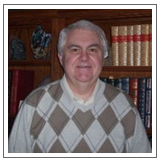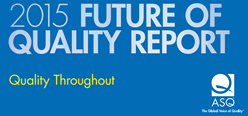A new interview of The QIC – Quality Interview Chain is here! My pleasure to present Larry Pope, an Experienced Quality Professional with more than 25 years of experience in the pharmaceutical field. Keep an eye on his challenge story, so worth it. Enjoy it!
SHARE > Nominate > Connect > Learn
* YOURSELF / OCCUPATION: Who are you and what you do?

I began my journey in Quality 29 years ago. My experience has been focused on pharmaceutical manufacturing (sterile injectable, solid dose, topical solutions/creams/ointments). My first job in Quality was in the Quality Control Laboratory as a bench chemist. After 6 years in the lab, I moved to Quality Assurance providing guidance for sterile fill manufacturing. I then took a detour to the “Dark Side,” and spent 6 years in various operational roles. I returned to Quality Assurance and had various roles including Site Head of Quality. I am currently working as Senior Quality Manager for contract manufacturing. My journey has allowed me to live in 7 different states and travel to 7 foreign countries. I am very active in ASQ. I have been ASQ Certified Quality Auditor since 2002. In April 2015, ASQ published an article I wrote concerning internal auditing. My educational background includes a Bachelor of Science degree in Chemical Engineering and a Master of Business Administration.
* CHALLENGES: What was the biggest challenge you faced in your job and how did you handle it?
The biggest challenge that I have faced in my career, so far, happened several years ago. The company I worked for had a business partner that wanted to introduce their product to the Japanese market. In pharmaceutical market place, Japan ranks 2nd in the world; therefore, this would mean a great deal for both companies. My role at the time was site Compliance so I was tapped to prepare the site for the inevitable pre-approval inspection. Since no one at the site or at our corporate office had experience with this type of inspection, I had no choice but to “roll up the shirt sleeves” and dive right in.
I started by reviewing the Japanese regulations, finding any gaps, and filling those gaps. In this process, I learned that the inspection would be conducted in Japanese (by regulation) thus I needed to engage the services of interpreters. The interpreters were brought in a couple months in advance of the inspection as a “mock” inspection. This allowed for (1) practice for the inspection, (2) the interpreters to learn about site specific phrases that would be used during the inspection, and (3) site personnel to learn and practice cultural norms for the inspection. In the final days before the inspection, we purchased a Japanese flag to be flown in a place of honor next to our US and state flags.
The day of the inspection arrived and the site staff were confident and ready. After the traditional introductions and exchange of business cards, the inspection started. It lasted five days but was very successful. After the closing meeting, the lead inspector took me aside and spoke to me in English (for the first time in 5 days). He said “I hope you did not feel we were being especially hard on you and your staff. You must understand that my role is to protect the Japanese people and ensure that only safe and effective drugs make it to the market.”
The moral of this story is to rely on your quality tools to help you prepare for those difficult situations. Also remember to always keep the customer in mind when you are making those daily Quality-related decisions.
* CONTINUOUS IMPROVEMENT: What are you doing to ensure you continue to grow and improve as a professional and/or as a person?
I was lucky enough to have teachers in high school and college that instilled in me a passion for continuous learning. I am also fortunate to be living in a time where all I have to do is go to the internet and all the newest and brightest ideas can be found. I start each day reviewing the latest information from the FDA (Food and Drug Administration) website. I learn what issues other companies are having and apply that knowledge so to prevent that issue at my site. I attend webinars on topics of interest. Another great source of information is ASQ. The website contains news about Quality from many industries. Finally, I network with my Quality colleagues at local ASQ section meetings, seminars, and social media.
* QUALITY QUOTE: Which is your favorite quality quote?
“Quality is not something you install like a new carpet or a set of bookshelves, you implant it. Quality is something you work at. It is a learning process.” by Dr. W. Edwards Deming
* MOTIVATION / PASSION: What motivates you to do what you do? What are you truly passionate about?
In the first few days of my life, I developed a very serious eye infection. Luckily, there was a pharmaceutical solution that cured the infection and saved my eyesight. Many years later, I started my first job allowed me to help others by making sure that my company’s pharmaceutical products were safe and effective. So, I would say that I am passionate about help people.
* ADVICE / RECOMMENDATION: What advice would you pass along to others taking the same path as you? Any specific books/blogs/authors you would like to recommend?
Don’t be afraid to step out of your comfort zone. You’ll be amazed what you will learn. I have known people that would say “I’ll never work for a company under a FDA Warning Letter or Consent Decree.” I learned the most about quality by taking positions with companies that had issues with regulatory agencies and helping them to improve.
A book recommendation: Willful Blindness by Margaret Heffernan – she walks you through several examples how bad things happening when we become willfully blind (ignoring the obvious). As Quality professionals, we should never be willfully blind but ever vigilant to make the hard decisions.
* FREE TIME: In your free time, what do you like to do to relax?
Movies, movies, movies – I love to escape into a good story and be transported and forget about things for a few hours.
I also find enjoyment in the time I spend on my blog. The blog is a place for me to share Quality and Science articles, quotes, and news that I find interesting.
* HUMOR: I’m convinced that humor at work is the best remedy to reduce stress and help you with your productivity; do you have any funny stories/videos/pictures you would like to share with us?
I recall seeing a video during my MBA course work. In the video Gill Rider, Head, Civil Service Capability Group, UK Cabinet Office recounted an incident that has stuck with me. She was late for a meeting and was running down the hallway when she was stopped. The gentleman asked her what she was doing. She responded by saying she was late for an important meeting. The gentleman asked again what she was doing. After she repeated the same response given previously, the gentleman said “No, you are telling everyone that things are out of control.” Upon reflection, Gill agreed with the gentleman and said “You can’t talk your way out of what you behave your way into.” This is a good adage for any Quality professional to keep in their back pocket for use in those occasions when the operational procedures have been bent just about as far as possible.
Share > Nominate > CONNECT > Learn
Share > Nominate > Connect > LEARN
Visit the QIC MAP to read and learn from other interviews.
Thank you so much LARRY POPE for being part of this project! I’ve really enjoyed your interview a lot!







